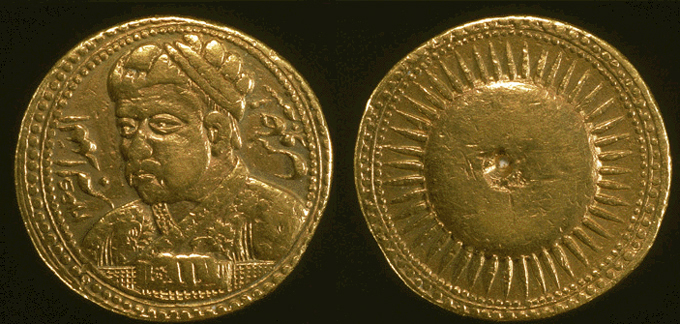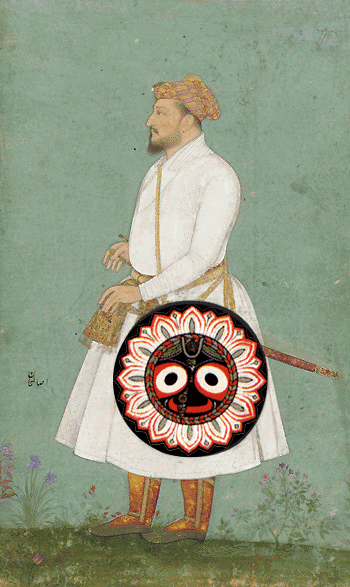
|
|
|
|
BY: SUN STAFF

Coin with Akbar and Sun, Inscribed with "Allahu Akbar" Sep 10, 2010 — CANADA (SUN) — A serial presentation of the Mughal effect on Vaisnava society. Over the course of our research for this series, we have occasionally read comments that suggest Orissa escaped the fate of much of northern India, and did not come under Mughal rule. But this is not actually the case. A number of detailed studies are available on the Mughal intrusion into Orissa, and we are particularly interested in how they influenced the worship of Lord Jagannatha at Puri Dhama.
In his book, Orissa Under the Mughals, Dr. B.C. Ray offers the following: "The Mughal conquest of Bengal not only changed the character of the Muslim population of that province, but also it affected the political life of Orissa. So far the principal center of the Afghan activity was Bengal. And from capital of Bengal the Afghans ruled over Orissa. But now as a result of the Mughal push from the north, the Afghan rulers were forced to move into Orissa. Even though the Afghan rule was brought to an end in Orissa by Raja Man Singh, later still the Afghans had already taken shelter and continued to remain in their hamlets and towns in the different parts of Orissa. In this way, a large stream of defeated Afghans flowed from Bengal to Orissa and greatly augmented the rural population. Of course, invasion of Orissa by Sulaiman Karrani in 1568 brought many Muslims into Orissa. But Akbar's victory over Daud in 1575 intensified the southward rush of Islam into this province." As we stated in "yesterday's segment, Raja Man Singh was a Rajput and a Vaisnava, who maintained his devotion to Sri Krsna throughout the years he served the Mughals, first under Akbar, and later under his son Jahangir. Not only did Raja Man Singh give financial support at the request of Srila Jiva Goswami for building the Radha-Damodar temple, he was also a sincere supporter of Lord Jagannatha in Puri. Raja Man Singh was deployed to serve as the governor of Bengal by Akbar in 1594 A.D. A few years prior to that, in 1587, there was a change of power in the Bengali and Orissan governments. Shahbaz Khan left his post there and returned to the Mughal court at Delhi. In his absence, local leaders in both states became more aggressive in their support of the Afghans, who again began pushing north into Bengal, trying to unseat the Mughals who have driven them from their seats of power in Bengal. From their new stronghold in Orissa, the Afghans once again began attacking the Mughals in Bengal. In response, Akbar assigned Raja Man Singh, his Rajput general and new Bengal governor, to deal with the Afghan instigators in Orissa. Due to various circumstances, including the health of key leaders, the potency of the Afghan forces, the lack of needed Mughal forces, etc., both the Afghan and Mughal leaders decided that it was time to arrive at a peace agreement. The Afghan king at this point in history was a young boy, and he was brought before Raja Man Singh to accept the subservient position in the peace negotiations. Arriving at Mughal headquarters with many gifts to be given in tribute, including 150 elephants, the Afghan king signed a peace treaty with Raja Man Singh. The Rajput general then sent to Emperor Akbar 1,004 elephants, as a gift to mark the victory. The peace treaty signed with the Orissan Afghans gave three primary concessions to the Mughals: 1) Emperor Akbar's name would be used in the kutba (offering of prayers) and would appear on Orissa's coins; 2) The Afghan ruler of Orissa would serve as the obedient and loyal vassal of Emperor Akbar; and 3) The Temple of Jagannatha Puri and surrounding lands in the district would be ceded to the Emperor. The fact that the Jagannath Temple was included in this political settlement indicates the very interesting balance of relationships that were in place at the time. The Puri temple had nothing to do with the Afghans, and this was Afghan treaty. It had more to do with Akbar's personal relationship with the Raja of Orissa, who was the custodian of the temple at that time. We'll explore the Emperor's connection to Puri Dham in the segments to follow. We can see how long the footprint of history is, both in the fact that even today, the Afghans are fighting like anything, this time with the Westerners, who are having as much difficulty defeating them as the Mughals did. Likewise, today we often hear the Muslim population proclaiming, "Allahu Akbar", the takbir slogan struck onto the coin bearing Akbar's profile, in 1605 A.D.

| |